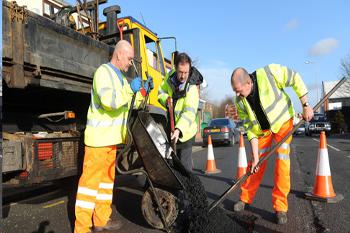The first in a new series of in-depth analysis pieces on major industry reports sees Surveyor put the spotlight on the Department for Transport’s (DfT) new Gearing up for Efficient Highway Delivery and Funding report, Matthew Lugg reports.
As part of the ongoing Highways Maintenance Efficiency Programme (HMEP)/DfT Regional Roads shows between January and March the Government are seeking views and evidence on their suggested mechanisms for the distribution of the £5.8bn funding (the capital proportion) for local highway maintenance from 2015/16 to 2020/21 which was announced in the Action for Roads report last year.
The Government is seeking views on the distribution of funding around three key themes:-
• Incentivising highways maintenance efficiencies in finding allocations
• A Highways Maintenance Challenge Fund
• Highway Maintenance Block Formula changes
Incentivising highways maintenance efficiencies in funding allocations
This theme is split into two parts; one about encouraging the uptake of highways asset management, the other about encouraging the uptake of efficiency principles.
Firstly I’ll put my cards on the table and say I am a great believer in incentivisation to drive up improvement.
Reward funding is nothing new however it is not universally popular. For example not so long ago local highway authorities (LHA’s) were scored on the quality of Local Transport Plans as part of the previous Government’s Comprehensive Performance Assessment (CPA) and then Comprehensive Area Assessment (CAA) performance management regime.
In my view this provided an incentive to drive up improvement. When I worked in both Leicestershire and Cambridgeshire County Councils we were only to keen to play our part in contributing to the success of the council in achieving 4 star status or Excellence by ensuring all the highway indicators were in the top quartile.So there is a precedent here but the key question is how do you measure and reward efficiencies?

Highways funding reforms being considered by DfT explained
Measuring auditable cashable efficiencies as we all know is a challenge and we mustn’t create an industry to do so. My view is that we should be considering this not just from a value for money perspective but we also need to take into account of the quality of the service and customer satisfaction. So ideally the measure should be across all these attributes in line with the NHT /HMEP’s CQC approach where not just cost but quality and the customer are taken into account.
In relation to encouraging the uptake of highways asset management the All Party Parliamentary Group (APPG) on Highway Maintenance has already advocated that highway asset management plans should be mandatory in a similar way to USA Transport Agencies. However having a good asset management plan (AM) doesn’t in itself necessarily lead to good AM. We need to see the evidence of the benefit of applying AM by assessing the impact of the investment in relation to overall road condition. We need a measure of good stewardship?
The Highway Maintenance Challenge Fund
This theme covers three areas of funding for major maintenance projects, cycleway and footway maintenance and finally alternative funding mechanisms.
Funding of major capital maintenance schemes has always been a challenge to justify. However there are certain maintenance projects that are inevitably very expensive and as “one offs” are too large to be funded out of the general capital allocation particularly for the smaller LHA’s.
So DfT has always made specific funding available for these projects e.g. major maintenance on a large bridge or tunnels for example.
Inevitability with challenge funding there will be winners and losers and the concern from the LHA’s will be the costs of bidding and then losing at a time when there isn’t enough money in the first place. So my advice is to keep any bidding process as simple as possible and then it won’t provide a disincentive for LHA’s to bid.
The second part of this challenge fund theme covers cycleway and footway maintenance. Encouraging cycling has been a high priority for the Coalition Government So the Government are asking if there should be a top sliced challenge fund for LHA’s to bid into. This again will raise similar concerns from LHA’s about the costs of having to bid. The third area included in this theme is described as ‘alternative funding mechanisms’ which predominately relates to street lighting upgrades-to date there has been funding for 30 PFI projects.
As an alternative to PFI funding, many LHA’s have invested in new street lighting technologies through an invest-to-save process funded predominately by prudential borrowing. Leicestershire CC has delivered energy efficiencies through invest-to-save funding for dimming and part night lighting. Other LHA’s are investing in LED lighting through similar initiatives. So if there is already a mechanism available to undertake this work, is a challenge fund really necessary?
Highway Maintenance Block Formula Changes
This section of the document covers issues around:-
• Detrunked Roads
• PFI grant
• Weightings for roads, bridges, and streetlighting
• and Road usage and traffic.
I could comment at length on each of these issues but perhaps the most important one in terms of its implications to funding is the criteria used in the block formula. As highway engineers we all know the main cause of structural damage to our road networks is heavy goods vehicles (HGVs) as the volume of cars causes little or no damage.
As shown in a table in the document no account is taken of any amount of road usage and traffic let alone HGVs, so I would be advocating some recognition of the impact of the volume of HGVs in the formula.